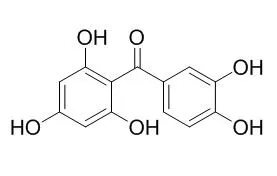Maclurin, an exceptional member of phytophenol family, was found to effectively protect against mesenchymal stem cells (MSCs) oxidative damage induced by hydroxyl radical (OH) at 62.1-310.5 μM.
METHODS AND RESULTS:
Antioxidant assays indicated that Maclurin could efficiently protect DNA from OH-induced damage at 114.6-382.2 μM, and scavenge OH, DPPH (1,1-diphenyl-2-picrylhydrazyl radical), ABTS(+) (2,2'-azino-bis(3-ethylbenzothiazoline-6-sulfonic acid radical), and bind Cu(2+) (IC50 values were respectively 122.87 ± 10.14, 10.15 ± 0.85, 0.97 ± 0.07, and 133.95 ± 11.92 μM). HPLC-DAD and HPLC-ESI-MS/MS analyses of the end-product of Maclurin reaction with DPPH clearly suggested that Maclurin (m/z = 261.12 [M-H](-)) donated two hydrogen atoms to DPPH (m/z = 394.06 [M](+)) to form ortho-benzoquinone moiety (λmax = 364 nm; m/z = 259.06 [M-H](-), loss of m/z = 28) and DPPH2 molecule (m/z = 395.03, 396.01), via hydrogen atom transfer (HAT) or sequential electron (e) proton transfer (SEPT), not radical adduct formation (RAF) mechanisms.
CONCLUSIONS:
Therefore, we concluded that: (i) Maclurin can effectively protect against OH-induced damages to DNA and MSCs, thereby it may have a therapeutic potential in prevention of many diseases or MSCs transplantation; (ii) a possible mechanism for Maclurin to protect against oxidative damages is OH radical-scavenging; (iii) Maclurin scavenges OH possibly through metal-chelating, and direct radical-scavenging which is mainly via HAT or SEPT mechanisms; and (iv) the protective and antioxidant effects of Maclurin can be primarily attributed to ortho-dihydroxyl groups, and ultimately to the relative stability of the ortho-benzoquinone form. |






 Cell. 2018 Jan 11;172(1-2):249-261.e12. doi: 10.1016/j.cell.2017.12.019.IF=36.216(2019)
Cell. 2018 Jan 11;172(1-2):249-261.e12. doi: 10.1016/j.cell.2017.12.019.IF=36.216(2019) Cell Metab. 2020 Mar 3;31(3):534-548.e5. doi: 10.1016/j.cmet.2020.01.002.IF=22.415(2019)
Cell Metab. 2020 Mar 3;31(3):534-548.e5. doi: 10.1016/j.cmet.2020.01.002.IF=22.415(2019) Mol Cell. 2017 Nov 16;68(4):673-685.e6. doi: 10.1016/j.molcel.2017.10.022.IF=14.548(2019)
Mol Cell. 2017 Nov 16;68(4):673-685.e6. doi: 10.1016/j.molcel.2017.10.022.IF=14.548(2019)